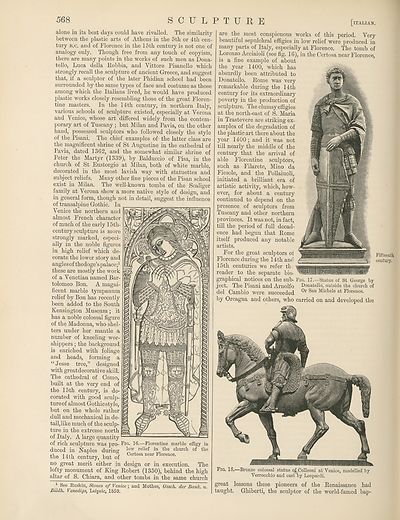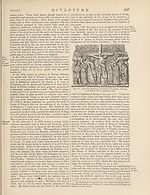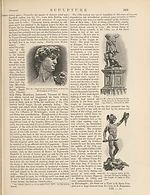Encyclopaedia Britannica > Volume 21, ROT-Siam
(578) Page 568
Download files
Complete book:
Individual page:
Thumbnail gallery: Grid view | List view

568
SCULPTURE
[ITALIAN.
alone in its best days could have rivalled. The similarity
between the plastic arts of Athens in the 5th or 4th cen¬
tury B.c. and of Florence in the 15th century is not one of
analogy only. Though free from any touch of copyism,
there are many points in the works of such men as Dona¬
tello, Luca della Robbia, and Vittore Pisanello which
strongly recall the sculpture of ancient Greece, and suggest
that, if a sculptor of the later Phidian school had been
surrounded by the same types of face and costume as those
among which the Italians lived, he would have produced
plastic works closely resembling those of the great Floren¬
tine masters. In the 14th century, in northern Italy,
various schools of sculpture existed, especially at Verona
and Venice, whose art differed widely from the contem¬
porary art of Tuscany; but Milan and Pavia, on the other
hand, possessed sculptors who followed closely the style
of the Pisani. The chief examples of the latter class are
the magnificent shrine of St Augustine in the cathedral of
Pavia, dated 1362, and the somewhat similar shrine of
Peter the Martyr (1339), by Balduccio of Pisa, in the
church of St Eustorgio at Milan, both of white marble,
decorated in the most lavish way with statuettes and
subject reliefs. Many other fine pieces of the Pisan school
exist in Milan. The well-known tombs of the Scaliger
family at Verona show a more native style of design, and
in general form, though not in detail, suggest the influence
of transalpine Gothic. In
Venice the northern and
almost French character
of much of the early 15th-
century sculpture is more
strongly marked, especi¬
ally in the noble figures
in high relief which de¬
corate the lower story and
angles of thedoge’s palace;1
these are mostly the work
of a Venetian named Bar¬
tolomeo Bon. A magni¬
ficent marble tympanum
relief by Bon has recently
been added to the South
Kensington Museum; it
has a noble colossal figure
of the Madonna, who shel¬
ters under her mantle a
number of kneeling wor¬
shippers ; the background
is enriched with foliage
and heads, forming a
“Jesse tree,” designed
with great decorative skill.
The cathedral of Como,
built at the very end of
the 15th century, is de¬
corated with good sculp¬
ture of almost Gothic style,
but on the whole rather
dull and mechanical in de¬
tail, like much of the sculp¬
ture in the extreme north
of Italy. A large quantity
of rich sculpture was pro- Fig. 16.—Florentine marble effigy in
duced in Maples durin" ^ow re^ef in the church of the
the 14th century, but o°f Certosa near Florence-
no great merit either in design or in execution. The
lofty monument of King Robert (1350), behind the high
altar of S. Chiara, and other tombs in the same church
1 See Ruskin, Stones of Venice ; and Mothes, Gesch. der Bank. u.
Bildh. Venedigs, Leipsic, 1859.
are the most conspicuous works of this period. Very
beautiful sepulchral effigies in low relief were produced in
many parts of Italy, especially at Florence. The tomb of
Lorenzo Acciaioli (see fig. 16), in the Certosa near Florence,
is a fine example of about
till nearly the middle of the
century that the arrival of
able Florentine sculptors,
such as Filarete, Mino da
Fiesole, and the Pollaiuoli,
initiated bnlliant cta^oj ^
graphical notices on the sub- Fig. 17.—Statue of St George by
ject. The Pisani and Arnolfo Donatello, outside the church of
del Cambio were succeeded ^an Michele at Florence,
by Orcagna and others, who carried on and developed the
Fig. 18.—Bronze colossal statue of Colleoni at Venice, modelled by
Verrocchio and cast by Leopardi.
great lessons these pioneers of the Renaissance had
taught. Ghiberti, the sculptor of the world-famed bap-
SCULPTURE
[ITALIAN.
alone in its best days could have rivalled. The similarity
between the plastic arts of Athens in the 5th or 4th cen¬
tury B.c. and of Florence in the 15th century is not one of
analogy only. Though free from any touch of copyism,
there are many points in the works of such men as Dona¬
tello, Luca della Robbia, and Vittore Pisanello which
strongly recall the sculpture of ancient Greece, and suggest
that, if a sculptor of the later Phidian school had been
surrounded by the same types of face and costume as those
among which the Italians lived, he would have produced
plastic works closely resembling those of the great Floren¬
tine masters. In the 14th century, in northern Italy,
various schools of sculpture existed, especially at Verona
and Venice, whose art differed widely from the contem¬
porary art of Tuscany; but Milan and Pavia, on the other
hand, possessed sculptors who followed closely the style
of the Pisani. The chief examples of the latter class are
the magnificent shrine of St Augustine in the cathedral of
Pavia, dated 1362, and the somewhat similar shrine of
Peter the Martyr (1339), by Balduccio of Pisa, in the
church of St Eustorgio at Milan, both of white marble,
decorated in the most lavish way with statuettes and
subject reliefs. Many other fine pieces of the Pisan school
exist in Milan. The well-known tombs of the Scaliger
family at Verona show a more native style of design, and
in general form, though not in detail, suggest the influence
of transalpine Gothic. In
Venice the northern and
almost French character
of much of the early 15th-
century sculpture is more
strongly marked, especi¬
ally in the noble figures
in high relief which de¬
corate the lower story and
angles of thedoge’s palace;1
these are mostly the work
of a Venetian named Bar¬
tolomeo Bon. A magni¬
ficent marble tympanum
relief by Bon has recently
been added to the South
Kensington Museum; it
has a noble colossal figure
of the Madonna, who shel¬
ters under her mantle a
number of kneeling wor¬
shippers ; the background
is enriched with foliage
and heads, forming a
“Jesse tree,” designed
with great decorative skill.
The cathedral of Como,
built at the very end of
the 15th century, is de¬
corated with good sculp¬
ture of almost Gothic style,
but on the whole rather
dull and mechanical in de¬
tail, like much of the sculp¬
ture in the extreme north
of Italy. A large quantity
of rich sculpture was pro- Fig. 16.—Florentine marble effigy in
duced in Maples durin" ^ow re^ef in the church of the
the 14th century, but o°f Certosa near Florence-
no great merit either in design or in execution. The
lofty monument of King Robert (1350), behind the high
altar of S. Chiara, and other tombs in the same church
1 See Ruskin, Stones of Venice ; and Mothes, Gesch. der Bank. u.
Bildh. Venedigs, Leipsic, 1859.
are the most conspicuous works of this period. Very
beautiful sepulchral effigies in low relief were produced in
many parts of Italy, especially at Florence. The tomb of
Lorenzo Acciaioli (see fig. 16), in the Certosa near Florence,
is a fine example of about
till nearly the middle of the
century that the arrival of
able Florentine sculptors,
such as Filarete, Mino da
Fiesole, and the Pollaiuoli,
initiated bnlliant cta^oj ^
graphical notices on the sub- Fig. 17.—Statue of St George by
ject. The Pisani and Arnolfo Donatello, outside the church of
del Cambio were succeeded ^an Michele at Florence,
by Orcagna and others, who carried on and developed the
Fig. 18.—Bronze colossal statue of Colleoni at Venice, modelled by
Verrocchio and cast by Leopardi.
great lessons these pioneers of the Renaissance had
taught. Ghiberti, the sculptor of the world-famed bap-
Set display mode to:
![]() Universal Viewer |
Universal Viewer | ![]() Mirador |
Large image | Transcription
Mirador |
Large image | Transcription
Images and transcriptions on this page, including medium image downloads, may be used under the Creative Commons Attribution 4.0 International Licence unless otherwise stated. ![]()
| Encyclopaedia Britannica > Encyclopaedia Britannica > Volume 21, ROT-Siam > (578) Page 568 |
|---|
| Permanent URL | https://digital.nls.uk/193634793 |
|---|
| Attribution and copyright: |
|
|---|---|
| Shelfmark | EB.17 |
|---|---|
| Description | Ten editions of 'Encyclopaedia Britannica', issued from 1768-1903, in 231 volumes. Originally issued in 100 weekly parts (3 volumes) between 1768 and 1771 by publishers: Colin Macfarquhar and Andrew Bell (Edinburgh); editor: William Smellie: engraver: Andrew Bell. Expanded editions in the 19th century featured more volumes and contributions from leading experts in their fields. Managed and published in Edinburgh up to the 9th edition (25 volumes, from 1875-1889); the 10th edition (1902-1903) re-issued the 9th edition, with 11 supplementary volumes. |
|---|---|
| Additional NLS resources: |
|

